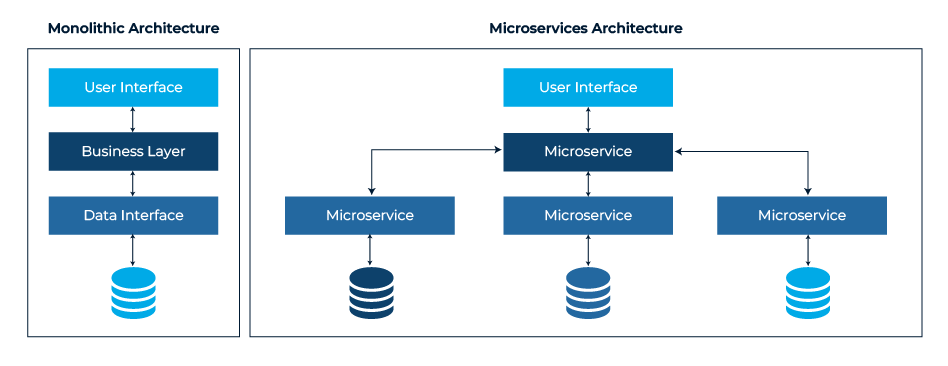Introduction
The journey to serverless computing began with traditional servers, where developers had to manage physical infrastructure aspects such as installation, scaling, and maintenance. Cloud servers improved this by offering virtualized, on-demand resources that scale automatically, minimizing manual intervention. However, they still require oversight, paving the way for serverless computing, where the cloud provider assumes full responsibility for managing the infrastructure.
Function-as-a-Service (FaaS) emerged as a core model, enabling developers to run individual functions in response to events without managing servers. When a function is triggered (e.g., HTTP request, database change), the provider handles compute resources and execution. FaaS scales automatically and charges based on execution time, typically in milliseconds. This makes it a cost-effective, efficient option for event-driven workloads.
How does FaaS work?
1) Monolithic architecture
This refers to a self-contained application that operates independently from other applications. It oversees the user interface, business logic, and data interactions internally, with its code relying on other parts of the same application.
2) Microservice architecture
This involves small, individual services, each responsible for handling specific tasks. These microservices are separate entities but collectively form a complete application.

- Unlike a monolithic architecture where the entire application is executed together, FaaS (Function-as-a-Service) allows microservice architecture to run each function independently based on specific triggers.
- In FaaS (Function-as-a-Service), each function is built to handle a specific task and is executed only when an event triggers it, such as generating a receipt when a user clicks a button.
- This event-driven model allows cloud providers to manage resources automatically, ensuring that functions only run when needed, without any background execution.
FaaS vs Other Cloud Services
1. Infrastructure-as-a-Service (IaaS): It provides virtual machines, storage, and networking, but requires users to manage the servers and underlying infrastructure themselves.
FaaS handles all underlying infrastructure tasks, allowing developers to focus entirely on writing and deploying code.
2. Platform-as-a-Service (PaaS): It offers a managed environment for building and deploying applications, but still requires management of runtimes and scaling.
FaaS abstracts away runtime concerns, letting developers deploy lightweight functions and concentrate fully on business logic.
3. Software-as-a-Service (SaaS): Delivers fully functional applications over the internet, managed by the provider.
FaaS enables fast development of custom SaaS-like solutions, reducing time-to-market and costs while giving enterprises flexibility for niche or internal applications.
4. Traditional Virtual Machines: Requires managing the entire os & software stack, along with scaling.
FaaS simplifies the infrastructure stack, enabling developers to execute standalone functions without the need to oversee servers, operating systems, or execution environments.
Benefits of FaaS
1. Cost Efficiency: Pay only for the time your functions run and the resources they use
2. Scalability: Automatically adjusts resources based on demand
3. Reduced Operational Overhead: No need to manage or maintain servers
4. Event-Driven Architecture: Executes code in response to specific events
5. Improved Security: Code runs in isolated environments managed by the provider
Major Cloud Providers Offering FaaS
1. Amazon Web Services (AWS) Lambda
AWS Lambda lets you run code in response to triggers from AWS services or custom events. It integrates effortlessly with the AWS ecosystem, offers automatic scaling, and supports various programming languages such as Node.js, Python, and Java.
2. Microsoft Azure Functions
Azure Functions provides a versatile platform for executing code triggered by various events. It integrates with Azure services, offers automatic and custom scaling, and supports languages including C#, JavaScript, and Python.
3. Google Cloud Functions
Google Cloud Functions enables you to build and run event-driven applications. It integrates with Google Cloud services, scales globally, and supports languages such as Node.js, Python, Go, and Java.
Use Cases of FaaS
1. Real-Time Data Processing: Process and analyze data streams, such as log files or sensor inputs, in real time to gain insights or trigger actions.
2. Event-Driven Applications: Execute code in response to events from sources like file uploads, database changes, or HTTP requests, enabling dynamic and responsive applications.
3. API Backend Services: Build scalable backend services for APIs that handle varying traffic loads without the need for server management.
4. Microservices: Deploy and manage individual components of a larger application as separate functions, improving modularity and scalability.
Challenges and Considerations
1. Cold Start Latency: Functions may experience delays (cold starts) when they are invoked after a period of inactivity, potentially affecting performance for latency-sensitive applications.
2. Limited Execution Time: Functions typically have execution time limits, which may not be suitable for long-running processes or tasks that require significant computation.
3. Vendor Lock-In: Relying on a specific cloud provider’s FaaS offering can lead to vendor lock-in, making it difficult to migrate to another provider or integrate with other platforms.
Conclusion
Function-as-a-Service (FaaS) offers a flexible and cost-effective way to run code in response to events without managing servers. It helps you scale applications easily and focus on development rather than infrastructure. However, it’s important to be aware of challenges like cold start latency, state management, and resource limits. By understanding these factors, you can make the most of FaaS and build efficient, scalable applications.





